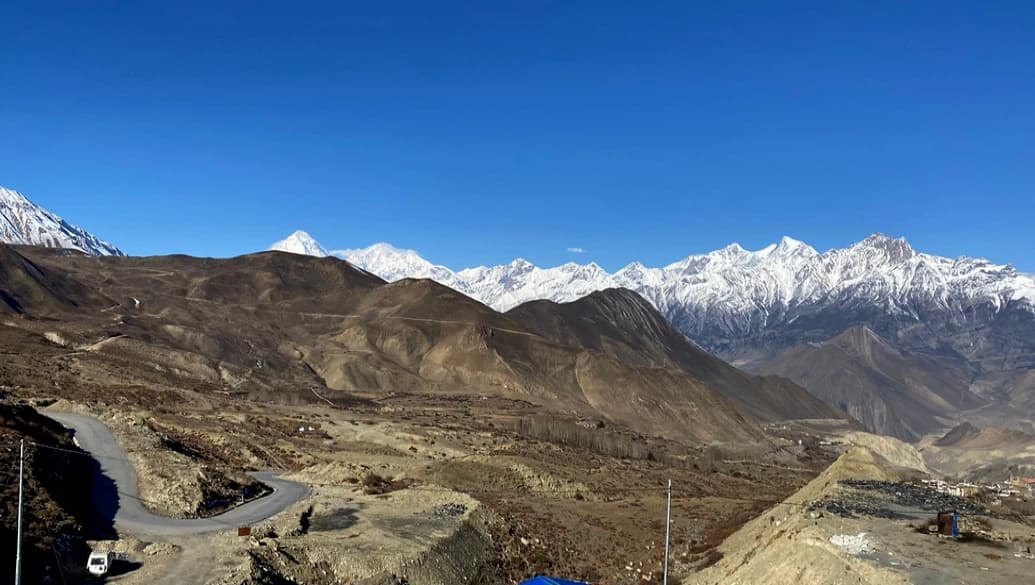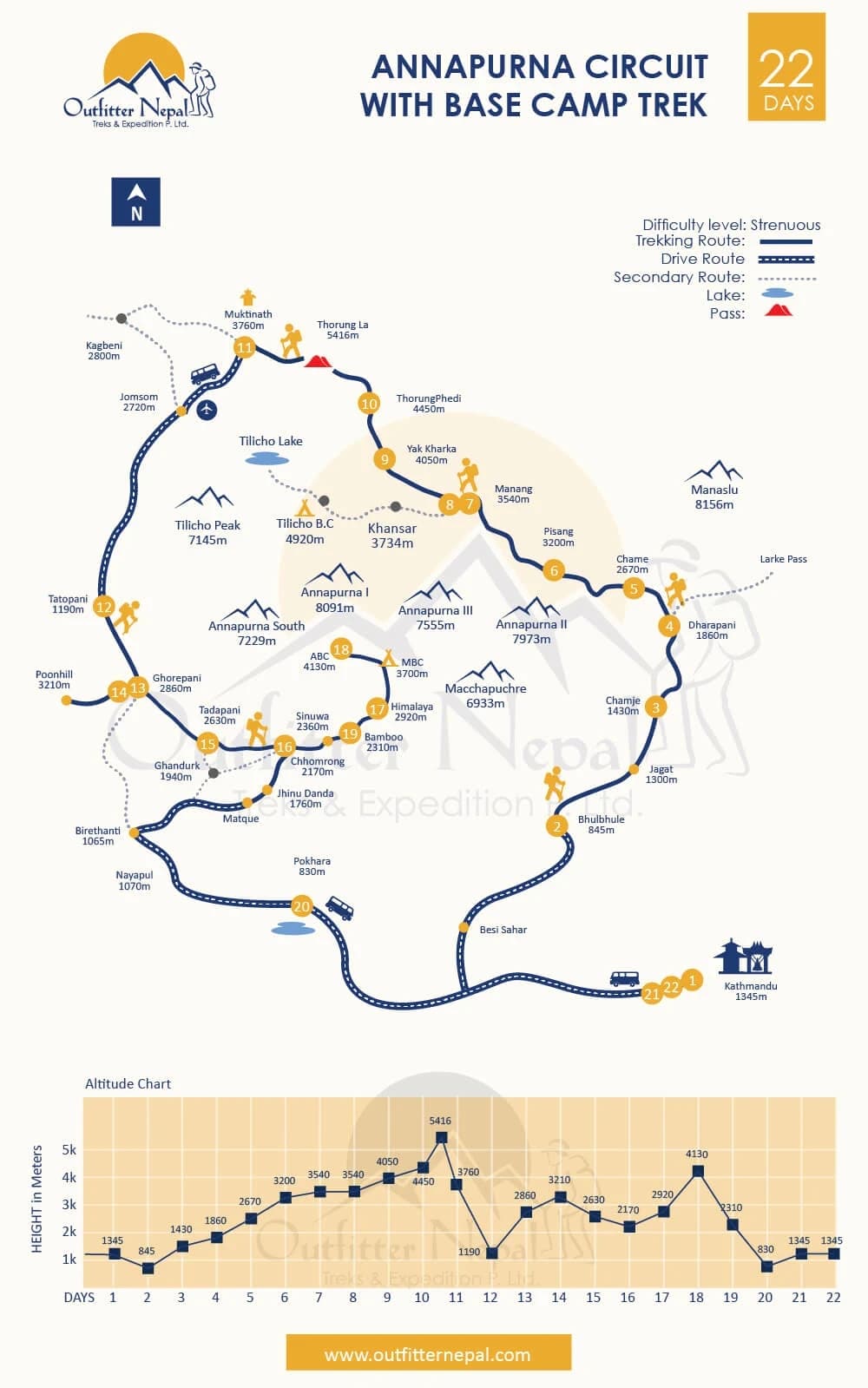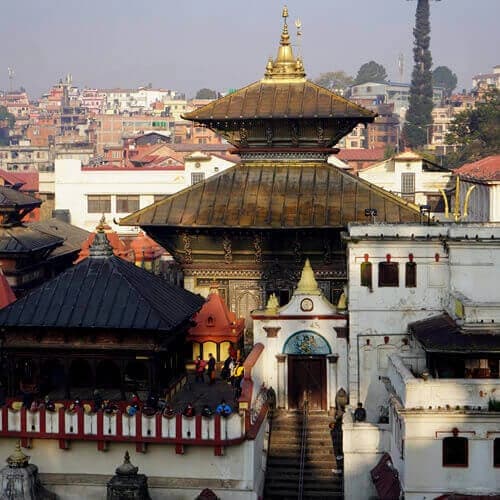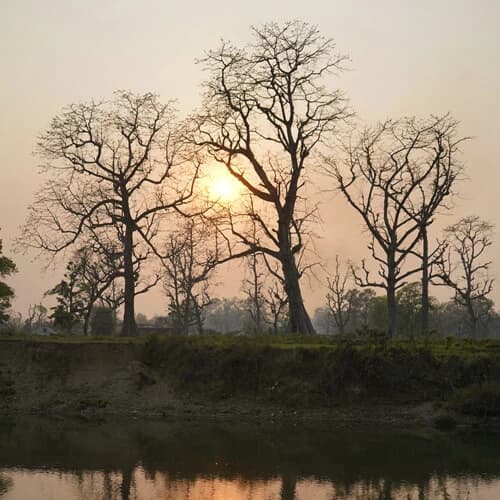Annapurna Circuit with ABC Trek Overview
Here begins the next leg of the Annapurna Circuit and Annapurna Base Camp - Ghorepani Poonhill Trail. You'll resume your trekking journey from Tatopani, taking a steep ascent to Ghorepani. The taxing hike day is followed by a rest day in the Magar village of Ghorepani, giving you the perfect opportunity for another highlight of the trek, a pre-dawn hike to Poonhill for glorious Himalayan sunrise.
Starting from Bhulbule, you'll walk around the Annapurna massif as a part of the Annapurna Circuit, passing by the Buddhist villages of Chame, Pisang, and Manang, decorated with Mani walls and prayer flags and crossing the challenging Thorung La Pass. Once you reach Muktinath and pay a visit to the holy Muktinath Temple, you divert from the original Annapurna Circuit Trekking and drive to Tatopani instead. This reduces the itinerary by a few days without missing anything crucial.
The trail continues toward Tadapani with a panoramic view of the Annapurna range. Consider yourself lucky if you're hiking during March and April because the Rhododendron forest turns bright red, pink, and white with fresh flower blooms along the trail.
Leaving the Ghorepani-Poonhill trail behind, we move ahead to the small village of Chhomrung and join the standard Annapurna Base Camp trekking route. Passing by small Gurung settlements and Machhapuchre Base Camp, we finally reach Annapurna Base Camp in the glacial basin of Annapurna Sanctuary, the last destination of our 22 Days Annapurna Circuit with Annapurna Base Camp Trek. After spending the night at the base of the Annapurna massif, we hike back to Matque via Bamboo and drive to Pokhara.
Let us take you through the virtual tour of the major highlights of the Annapurna Circuit with Annapurna Base Camp 22 Days for a clear idea of what you're signing up for. This strenuous trekking trip is full of challenges, but the following details definitely make it worthwhile.
Best Features of the Annapurna Circuit with ABC Trek
- Cover 3 treks of the Annapurna Region in 22 days
- Thrilling yet scenic drive from Kathmandu to Bhulbhule and Muktinath to Tatopani
- Standing at the base Camp of Annapurna I, the world's 10th-tallest mountain peak
- Crossing the taxing Thorung La Pass at 5416 meters, the highest point of the trek
- Surround yourself with 7000+ meters high mountains
- Visiting Muktinath Temple, a sacred temple of Hindus and Buddhists in rural Mustang
- Relax the sore muscles at a hot water spring in Tatopani
- Witness the mesmerizing sunrise view of the Himalayan panorama in Poonhill
- Staying with the humble locals from Gurung, Magar, Thakali, and Manage ethnicities
- Trek across varied climatic regions, including tropical, alpine, and high-altitude desert
3 weeks of trekking in the wild Annapurna Himalayas
As cool as it sounds, spending 3 weeks in the wilderness of the deep Himalayas is certainly a life-changing experience. The hard-core trekking adventure in the rugged high-altitude terrain, sometimes exceeding 5000 meters above sea level, tests your limits. No matter how high you ascend, the giant mountains keep you grounded. It's going to be tough. You might even feel like giving up in the face of the cold mountains. But imagine the moment when you actually complete the trek; you'd be so proud of yourself. You'll feel invincible.
Staying overnight at the base of the world's 10th-tallest mountain peak
Once you're in close proximity to the majestic Annapurna, you'll forget all the discomfort you felt as you ascended through the challenging and rocky Himalayan landscape. You experience euphoria as you gaze out over the mountain scenery from Annapurna Base Camp (4130 m). As opposed to EBC, you can stay at the ABC, and the glorious sunrise in the morning is something to wait for. Even though it's freezing outside, the atmosphere in the teahouse is warm and cozy, with trekkers sharing their hiking tales.
Walking by the highest trekking pass, Thorung La Pass, at 5416 m
The towering Thorang La Pass sits at the height of 5416 meters between the peaks of Khatung Kang and Yakwa. Given that you must go along a rocky, steep trail to reach the top of the pass, it is considered the most difficult hike in the area. You'll feel as though your dedication and hard work were justly rewarded when you finally reach the top and see the breathtaking panorama of the neighboring mountains. It is impossible to adequately express the sense of achievement you feel after soaking in the beautiful vista from the pass.
Breathtaking views of 7000+ meters of mountains surrounding you
It goes without saying that you will see the Annapurna range's mountains during the Annapurna Circuit with Base Camp Trek of 22 days. This 55-kilometer-long massif is home to many peaks, including Annapurna (8091 m), Machhapuchhre (6993 m), Gangapurna (7455 m), Nilgiri Himal (7061 m), Tilicho Peak (7135 m), and others. You'll also get to witness Mt. Dhaulagiri (8167 m), Mt. Manaslu (8163 m), Mt. Lamjung Himal (6986 m), and other mountains in the distance. In fact, you'll find mountains with snow on top all around you.
Vegetation ranging from tropical to alpine to high-altitude desert
The unique 22 days trek of Annapurna Circuit and Base Camp begins in the subtropical landscape of green forests and rivers flowing with gushing sounds. You trek past innumerable terraced paddies and farms while enjoying the warm weather. Within a few days, the alpine vegetation with arid slopes and dismal ravines surrounded by snow-capped mountains comes into view. After crossing Thorung La Pass, you'll enter the desert-like landscape with dry soil void of any vegetation. You'll again drive down to the tropical vegetation before ascending to the Annapurna Base Camp.
Seek blessings from the holy Muktinath Temple
At the foot of Thorong La Pass lies Muktinath Temple, one of the most revered Hindu and Buddhist pilgrimage sites. It is believed that visiting Muktinath Temple, known as Mukti Kshetra (place of liberation), will absolve you of all your sins and bring you luck. Thousands of pilgrims travel to the temple from different regions of India and Nepal to bathe in the temple's pond and the taps. The 22-day Annapurna Circuit with Base Camp Trek is a fantastic opportunity to pray for blessings for yourself.
Mesmerizing sunrise view from Poonhill
Ghorepani-Poonhill is a different trekking trail well-known for its breathtaking sunrise view against the distant mountains. The panoramic view of the Annapurna Range, along with Mt. Machhapuchre and Dhaulagiri, lights up in the golden hue of glorious Himalayan sunrise. This magnificent scenery is visible from the hilltop Poonhill, which is just a short uphill hike from Ghorepani. Including this trail in our 22-day Annapurna region trek is a cherry on top.
Dip in the natural hot spring of Tatopani
During the Annapurna Circuit with ABC Trek of 22 days, we pass by Tatopani (translated to "hot water" in Nepali), which has a hot spring in the area. It is thought that spring water has a unique ability to heal and soothe aches and pains. Taking a hot spring bath is said to cleanse the spirit as well. Thus, we recommend you soak in the hot spring briefly before ascending to Ghorepani.





